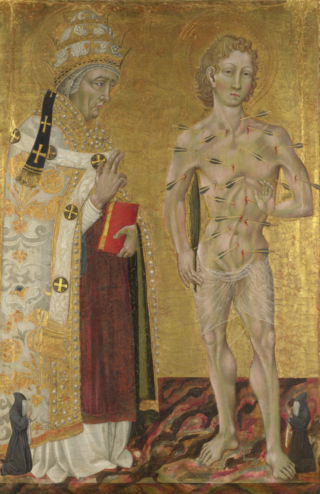Related Research Articles

Canonization is the declaration of a deceased person as an officially recognized saint, specifically, the official act of a Christian communion declaring a person worthy of public veneration and entering their name in the canon catalogue of saints, or authorized list of that communion's recognized saints.
The 380s decade ran from January 1, 380, to December 31, 389.

Grenoble is the prefecture and largest city of the Isère department in the Auvergne-Rhône-Alpes region of southeastern France. It was the capital of the Dauphiné historical province and lies where the river Drac flows into the Isère at the foot of the French Alps.

Pope Pontian was the bishop of Rome from 21 July 230 to 28 September 235. In 235, during the persecution of Christians in the reign of the Emperor Maximinus Thrax, Pontian was arrested and sent to the island of Sardinia.

Pope Fabian was the bishop of Rome from 10 January 236 until his death on 20 January 250, succeeding Anterus. A dove is said to have descended on his head to mark him as the Holy Spirit's unexpected choice to become the next pope. He was succeeded by Cornelius.

Menas, considered a saint in the Calcedonian affirming church and by extension both the Eastern Orthodox Church and Roman Catholic Church of modern times, was born in Alexandria, and enters the records in high ecclesiastical office as presbyter and director of the Hospital of Sampson in Constantinople, where tradition has him linked to Saint Sampson directly, and in the healing of Justinian from the bubonic plague in 542. He was appointed Patriarch of Constantinople by the Byzantine emperor Justinian I on 13 March 536. Pope Agapetus I consecrated him to succeed Anthimus, who was condemned as a monophysite. This was the first time that a Roman Pope consecrated a Patriarch of Constantinople.
An apostolic see is an episcopal see whose foundation is attributed to one or more of the apostles of Jesus or to one of their close associates. In Catholicism, the phrase "The Apostolic See" when capitalized refers specifically to the See of Rome.

Saint Publius was a 1st century Maltese Christian bishop and saint. He is considered the first Bishop of Malta and one of the first Bishops of Athens.

Cularo was the name of the Gallic city which evolved into modern Grenoble. It was renamed Gratianopolis in 381 to honor Roman emperor Gratian.
The Archbishopric of Vienne, named after its episcopal seat in Vienne in the Isère département of southern France, was a metropolitan Roman Catholic archdiocese. It is now part of the Archdiocese of Lyon.

The Diocese of Grenoble–Vienne-les-Allobroges is a Latin Church diocese of the Catholic Church in south-eastern France. The diocese, erected in the 4th century as the Diocese of Grenoble, comprises the department of Isère and the former canton of Villeurbanne (Rhône), in the Region of Rhône-Alpes. In 2006, the name was changed from the diocese of Grenoble to the diocese of Grenoble–Vienne. The current bishop is Jean-Marc Eychenne, appointed on 14 September 2022.

Saint Julian of Le Mans is a saint venerated in both the Roman Catholic and Orthodox Church, honoured as the first bishop of Le Mans. His feast day is 27 January. The translation of his relics is celebrated on 25 July.
Domninus may refer to:
Western Rite Orthodoxy, also called Western Orthodoxy or the Orthodox Western Rite, are congregations within the Eastern Orthodox tradition which perform their liturgy in Western forms.
The following outline is provided as an overview of and topical guide to the Catholic Church:

Domnin was the first Bishop of Digne, from 364 to 379 and was also the archbishop of the city of Vienne, Isère. He is venerated as a saint in the Catholic Church.
The following is a timeline of the history of the city of Grenoble, France.
Saint Ceratus of Grenoble was a 5th-century bishop of Gratianopolis, now Grenoble. He is venerated as a saint by the Roman Catholic Church; his feast day is celebrated on 6 June.

Saint Ferjus of Grenoble was the bishop of Gratianopolis in the 7th century. He was assassinated about 660 A.D., probably on the instruction of Clotaire III, meeting the same fate as other bishops who defied Clotair's authority.

Petar Zimonjić was a bishop of the Serbian Orthodox Church serving as the metropolitan of Dabar-Bosnia in the Kingdom of Yugoslavia from 1920 until the beginning of World War II.
References
- ↑ Jean-Joseph-Antoine Pilot Thorey, History of Grenoble and surrounding area from its foundation as the Cularo until today (Baratier brothers, 1829) page 304
- ↑ Bernard Bligny (dir.), Le diocèse de Grenoble, Beauchesne, Paris, 1979.
- 1 2 Nominis: Saint Domnin
- ↑ Forum orthodoxe.com: saints pour le 3 novembre du calendrier ecclésiastique